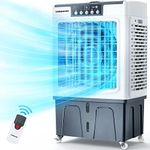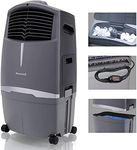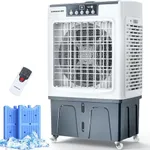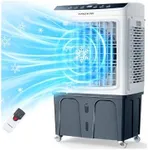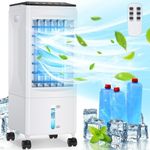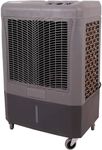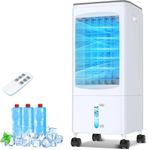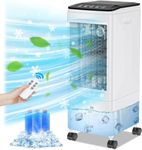Buying Guide for the Best Evaporative Coolers
Evaporative coolers, also known as swamp coolers, are a popular way to cool indoor and outdoor spaces, especially in dry climates. Unlike traditional air conditioners, they use water evaporation to lower the temperature, making them energy-efficient and eco-friendly. When choosing an evaporative cooler, it's important to consider your space, climate, and how you plan to use the cooler. Understanding the key specifications will help you find a model that fits your needs and provides effective cooling.Cooling Capacity (CFM)Cooling capacity, measured in Cubic Feet per Minute (CFM), tells you how much air the cooler can move in a minute. This is important because it determines how large an area the cooler can effectively cool. Smaller spaces like bedrooms or offices may only need a cooler with a lower CFM, while larger areas like living rooms or patios require higher CFM. To pick the right CFM, estimate the size of your space in square feet and match it to the recommended CFM range provided by manufacturers. Generally, higher CFM means more powerful cooling, but it's best to choose a model that matches your room size for efficient performance.
Water Tank CapacityThe water tank capacity indicates how much water the cooler can hold at one time. This matters because a larger tank allows the cooler to run longer without needing a refill, which is convenient for continuous use. Small tanks (under 5 gallons) are suitable for personal or spot cooling, while medium tanks (5-10 gallons) work well for average-sized rooms. Large tanks (over 10 gallons) are ideal for big spaces or outdoor use. If you want less frequent refilling, especially for overnight or all-day use, choose a cooler with a larger tank.
PortabilityPortability refers to how easy it is to move the cooler from one place to another. Some coolers are lightweight and have wheels or handles, making them easy to relocate, while others are heavier and more stationary. If you plan to use the cooler in different rooms or outdoors, look for features like caster wheels and a compact design. For fixed installations, portability may not be as important. Think about where and how often you'll move the cooler to decide how much portability you need.
Fan Speeds and ControlsFan speeds and controls determine how much you can adjust the airflow and cooling intensity. Most coolers offer multiple speed settings, such as low, medium, and high, allowing you to customize comfort based on the temperature and your preference. Some models also have remote controls or digital panels for easier operation. If you like having control over the cooling level or want convenience, look for a cooler with more speed options and user-friendly controls.
Air Filter and MaintenanceMany evaporative coolers include air filters to trap dust and particles, improving air quality. The type and quality of the filter can affect how clean the air is and how often you need to clean or replace it. Simple mesh filters are easy to maintain, while advanced filters may offer better purification but require more upkeep. If you have allergies or want cleaner air, choose a model with a good filter and check how easy it is to clean or replace.
Noise LevelNoise level refers to how loud the cooler is when operating. This is important if you plan to use the cooler in bedrooms, offices, or quiet spaces. Some coolers are designed to run quietly, while others may be noisier, especially at higher speeds. If noise is a concern, look for models that advertise quiet operation or check user reviews for feedback on sound levels. Choose a cooler that matches your comfort with background noise.

